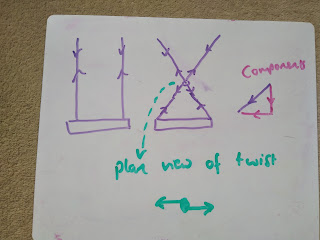Tuesday, 31 October 2023
Long shutter setting
Friday, 27 October 2023
Wifi
Thursday, 26 October 2023
Vega in the constellation Lyra
Vega is well known for being a bright star so I was wondering why. It turns out that it is very close at only 25 light years which explains a lot about the brightness. But it is twice as heavy as the sun so that means it burns though its fuel faster and is hotter, a class A star. These hotter stars have much shorter lives; I was amazed to discover that it was only "born" during our Cambrian period. Using data from here, it is have roughly twice the radius of the Sun, so it has 4x the surface area. The temperature is roughly 1.7x. By Stefan's Law, that would mean the luminosity is 4 x 1.7 = 33x more luminous. The data gives 40x but there are quite large ranges in the radius and temperature data.
Wednesday, 25 October 2023
Sunspots and luminosity
Tuesday, 24 October 2023
Wind turbine carbon footprint
Monday, 23 October 2023
Arcturus
Last month the constellation Bootes was prominent in the western sky after sunset. I've coloured it in the photograph. The circled star at the bottom is Arcturus, which is the brightest star in our northern skies. It is a red giant so has expanded giving a much larger surface area and hence a high luminosity since Stefan's Law says that luminosity is directly proportional to luminosity. It is also very near, being only 37 light years away. It is a K class star. The classes are OBAFGKM (which I remember as Oh Be A Fine Guy, Kiss Me). K stars are much cooler.
Saturday, 21 October 2023
BESS - Battery Energy Storage Systems
I had thought that we stored excess electrical energy in this country by using pumped storage but it seems that we are now heading towards using fields of lithium ion battery banks. I got the hint from the BBC and from there found the interactive renewables map from this website.
Wednesday, 18 October 2023
Are wind turbines more powerful in the rain?
Monday, 16 October 2023
Air-source heat pump
Sunday, 15 October 2023
Measuring in chains
Friday, 13 October 2023
More sunspots
Thursday, 12 October 2023
Wednesday, 11 October 2023
Gate like an electric field pattern
Sunday, 8 October 2023
Last coal-fired power station
Saturday, 7 October 2023
Learning things about electric cars
It started when someone said that you can't tow an electric car - a consideration in a muddy festival car park field. And it turns out that for the vast majority of electric cars, they are correct. There is no neutral gear. A flat bed truck is needed. Also, the vast majority of electric cars have only one gear anyway. There's a lot of interesting stuff I need to consider here about torques and transmission.
Friday, 6 October 2023
New pylons and power lines
We were up close to the new T pylons in the south-west. I think they have a lower profile so might be deemed to be less intrusive. I read an article in The Guardian that makes relevant comments about the new power lines that will have to be built to achieve Net Zero. The new centres of power generation are in Scotland or the North Sea whereas the old power lines connected to large power stations in the middle of England.
Thursday, 5 October 2023
Spinning on the swing
We wound up the swing and then it span when released.
Hooking the chains over each other pulls them in and ensures that there is a horizontal component to the tension force in the chain. There is a horizontal component in each of the pair of chains pulling in opposite directions. The key is that the way the chains are wrapped side by side, so the horizontal components are not perfectly lined up. This produces a couple, a turning moment. The swing rotates.





















